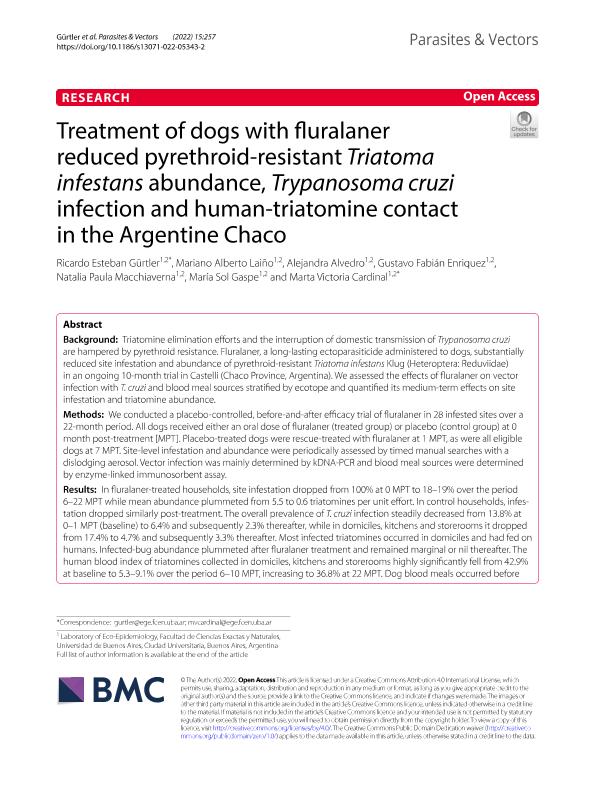Artículo
Treatment of dogs with fluralaner reduced pyrethroid-resistant Triatoma infestans abundance, Trypanosoma cruzi infection and human-triatomine contact in the Argentine Chaco
Gurtler, Ricardo Esteban ; Laiño, Mariano Alberto
; Laiño, Mariano Alberto ; Alvedro, Alejandra
; Alvedro, Alejandra ; Enriquez, Gustavo Fabián
; Enriquez, Gustavo Fabián ; Macchiaverna, Natalia Paula
; Macchiaverna, Natalia Paula ; Gaspe, Maria Sol
; Gaspe, Maria Sol ; Cardinal, Marta Victoria
; Cardinal, Marta Victoria
 ; Laiño, Mariano Alberto
; Laiño, Mariano Alberto ; Alvedro, Alejandra
; Alvedro, Alejandra ; Enriquez, Gustavo Fabián
; Enriquez, Gustavo Fabián ; Macchiaverna, Natalia Paula
; Macchiaverna, Natalia Paula ; Gaspe, Maria Sol
; Gaspe, Maria Sol ; Cardinal, Marta Victoria
; Cardinal, Marta Victoria
Fecha de publicación:
12/2022
Editorial:
BioMed Central
Revista:
Parasites and Vectors
ISSN:
1756-3305
Idioma:
Inglés
Tipo de recurso:
Artículo publicado
Clasificación temática:
Resumen
Background: Triatomine elimination efforts and the interruption of domestic transmission of Trypanosoma cruzi are hampered by pyrethroid resistance. Fluralaner, a long-lasting ectoparasiticide administered to dogs, substantially reduced site infestation and abundance of pyrethroid-resistant Triatoma infestans Klug (Heteroptera: Reduviidae) in an ongoing 10-month trial in Castelli (Chaco Province, Argentina). We assessed the effects of fluralaner on vector infection with T. cruzi and blood meal sources stratified by ecotope and quantified its medium-term effects on site infestation and triatomine abundance. Methods: We conducted a placebo-controlled, before-and-after efficacy trial of fluralaner in 28 infested sites over a 22-month period. All dogs received either an oral dose of fluralaner (treated group) or placebo (control group) at 0 month post-treatment [MPT]. Placebo-treated dogs were rescue-treated with fluralaner at 1 MPT, as were all eligible dogs at 7 MPT. Site-level infestation and abundance were periodically assessed by timed manual searches with a dislodging aerosol. Vector infection was mainly determined by kDNA-PCR and blood meal sources were determined by enzyme-linked immunosorbent assay. Results: In fluralaner-treated households, site infestation dropped from 100% at 0 MPT to 18–19% over the period 6–22 MPT while mean abundance plummeted from 5.5 to 0.6 triatomines per unit effort. In control households, infestation dropped similarly post-treatment. The overall prevalence of T. cruzi infection steadily decreased from 13.8% at 0–1 MPT (baseline) to 6.4% and subsequently 2.3% thereafter, while in domiciles, kitchens and storerooms it dropped from 17.4% to 4.7% and subsequently 3.3% thereafter. Most infected triatomines occurred in domiciles and had fed on humans. Infected-bug abundance plummeted after fluralaner treatment and remained marginal or nil thereafter. The human blood index of triatomines collected in domiciles, kitchens and storerooms highly significantly fell from 42.9% at baseline to 5.3–9.1% over the period 6–10 MPT, increasing to 36.8% at 22 MPT. Dog blood meals occurred before fluralaner administration only. The cat blood index increased from 9.9% at baseline to 57.9–72.7% over the period 6–10 MPT and dropped to 5.3% at 22 MPT, whereas chicken blood meals rose from 39.6% to 63.2–88.6%. Conclusion: Fluralaner severely impacted infestation- and transmission-related indices over nearly 2 years, causing evident effects at 1 MPT, and deserves larger efficacy trials.
Archivos asociados
Licencia
Identificadores
Colecciones
Articulos(IEGEBA)
Articulos de INSTITUTO DE ECOLOGIA, GENETICA Y EVOLUCION DE BS. AS
Articulos de INSTITUTO DE ECOLOGIA, GENETICA Y EVOLUCION DE BS. AS
Citación
Gurtler, Ricardo Esteban; Laiño, Mariano Alberto; Alvedro, Alejandra; Enriquez, Gustavo Fabián; Macchiaverna, Natalia Paula; et al.; Treatment of dogs with fluralaner reduced pyrethroid-resistant Triatoma infestans abundance, Trypanosoma cruzi infection and human-triatomine contact in the Argentine Chaco; BioMed Central; Parasites and Vectors; 15; 1; 12-2022; 257-257
Compartir
Altmétricas



